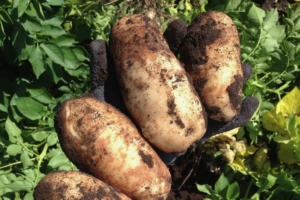AGVISE Potato Petiole Analysis: Informative, Accessible, and Easy-to-Understand Reports
Irrigated potato production is an intensive cropping system. It requires proactive labor, critical decision-making tools, and well-timed nutrient management. There is a fine line between supplying adequate plant nutrition and applying too much, which could cause potato tuber defects like mishappen tubers or hollow heart, reducing the marketable potato yield.
Before seed potatoes go in the ground, potato agronomists begin with a good soil fertility plan based on precision soil sampling (grid or zone). Once potatoes have emerged, the next step is monitoring the soil and plant nutrient status to ensure the potato crop has no deficient or excess nutritional problems. The in-season monitoring is done with paired potato petiole and soil samples. The petiole and soil sampling starts about 30 days after emergence, then taken every week during the growing season.
A successful in-season potato monitoring program requires fast turnaround and reliable service on petiole and soil samples. This is where AGVISE Laboratories has excelled in serving the potato industry because we know the petiole and soil test results will be used immediately to make fertilizer and irrigation decisions on the fly. To make the data immediately available, the petiole and soil test results are posted online to the AGVISE website with next-day turnaround after the samples arrive at the laboratory.
It is also critical that the petiole and soil test results are easy to interpret and understandable to everyone on the agronomy staff. The AGVISE petiole and soil test report displays results in a graphic format, enabling agronomists to quickly evaluate plant nutrient levels and watch trends over the growing season. An example potato petiole and soil nutrient report is shown below. The report includes a weekly graph of petiole nitrate, phosphorus, and potassium alongside with soil ammonium- and nitrate-nitrogen.
For most irrigated potato producers, weekly potato petiole sampling is a given. But, an increasing number are also including soil samples for ammonium- and nitrate-nitrogen analysis each week. The soil nitrogen data is critical for timing an in-season nitrogen application. There are periods where very fast potato vegetative growth can cause unusually low petiole nitrate-nitrogen levels. The soil nitrogen data prevents overreaction to low petiole nitrate-nitrogen levels and avoids application of extra nitrogen, which could create potential tuber quality issues down the road.
AGVISE Laboratories has provided potato petiole and soil analysis services to the potato industry in the United States and Canada for over 40 years. In 2020, we analyzed over 12,000 potato petiole samples for potato growers at our Northwood, ND and Benson, MN laboratories. We know that timely information is important to our customers, and we are always making improvements to our service and support. If you have any questions, please talk with one of our agronomists or soil scientists about getting started with potato petiole analysis.


